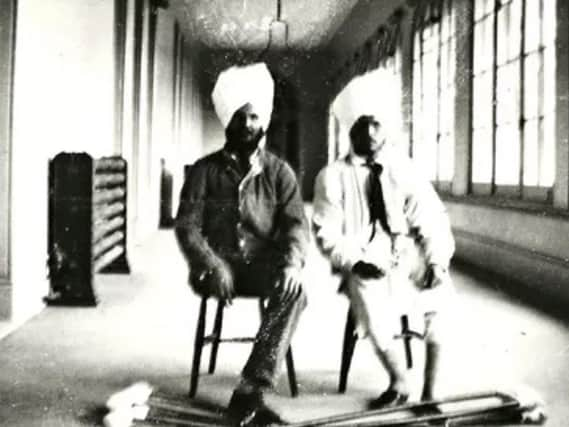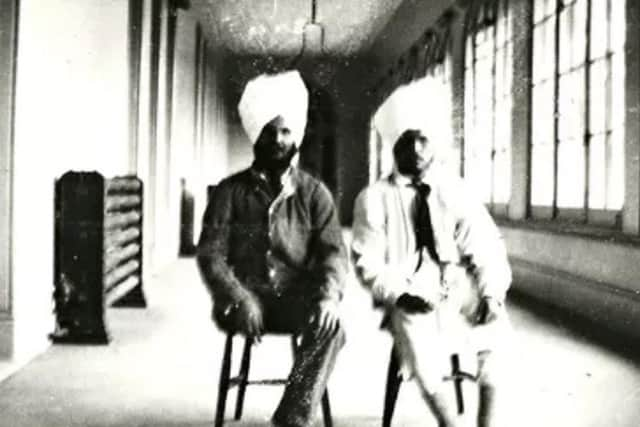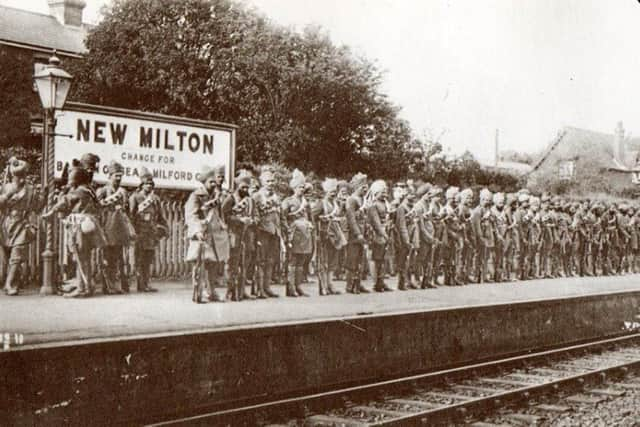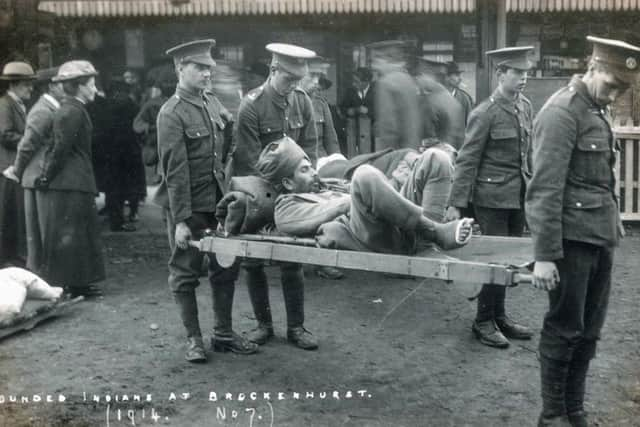'˜A deep impression on our hearts' '“ The Hampshire history of the First World War's Indian soldiers 7,000 miles from home


In 1914, as thousands of young men left Portsmouth and south Hampshire for the war, the area welcomed unfamiliar visitors from the far side of the world: thousands of Hindus, Muslims and Sikhs from India.
They came as soldiers of the British Indian Army, which was fighting on the western front '“ providing one third of the British forces in the trenches in the war's first autumn, with stories of their bravery getting almost more attention in the British press than the Tommies. From 1914, the Home Office and other government departments, working with charities such as the Red Cross, arranged for 15,000 Indian troops wounded in France and Flanders to be cared for on the south coast of England. As a result, several Indian hospitals and convalescent centres appeared in Hampshire, run by Urdu-speaking British and Indian doctors, nurses and orderlies. They were dotted about from the New Forest village of Brockenhurst to further south at New Milton, Barton-on-Sea and Milford-on-Sea, and across Southampton Water at Netley. Some of the Indian hospitals and convalescent centres were requisitioned local businesses, including Brockenhurst's Balmer Lawn Hotel and Barton's Grand Marine Hotel. Some were ready-made like the great military hospital at Netley founded by Queen Victoria, said to have been the world's longest hospital at 435 metres end to end.
Advertisement
Hide AdAdvertisement
Hide AdOthers were improvised outdoors, in clusters of metal and wooden sheds which quickly acquired local nicknames; those at Tile Barn on a ridge overlooking the New Forest were known as '˜Tin Town'. For locals, it was the first time they had encountered such large numbers of Indians. They regularly saw the Indian patients '“ the most famous of whom was Khudadad Khan, a machine gunner who won the first Indian VC at Ypres '“ coming or going at New Milton and other local railway stations.


They also saw the Indians standing or squatting to chat and smoke by the hospitals; out and about in the villages and countryside on guided sight-seeing tours in motor cars; or walking on the seafront and in the New Forest. '˜We are 7,000 miles away from home', the Indian patients often lamented. But for many Hampshire soon felt like a home from home.
They were struck by the sympathy and generosity of the locals' reception. '˜We receive welcome by their cheerful faces, and by their waving hands and handkerchiefs', said one group of Indians at Barton, who were regularly handed sweets and other spontaneous gifts by passers-by. Such local warmth, the Indians said, '˜has made a deep impression on our hearts.
'˜When we go back to India we shall talk about the comforts we have had here, and sing praises to the British public for the kind treatment we have had from them.'
Advertisement
Hide AdAdvertisement
Hide AdThe Indian patients were known for their politeness and smiles, contributing to their overwhelmingly positive local reputation. '˜On behalf of the whole community, I should like to express how much we have appreciated their presence,' the vicar of Milford, M. C. H. Collet, wrote in 1916 to the British doctor in charge of the Indian convalescent centre near his vicarage. He added '˜how deeply we have valued the opportunity of seeing and getting to know some of our [Asian] fellow subjects, whose loyalty to and sacrifices for our King and empire have thrilled the whole nation.' Meanwhile the Indian patients had special visitors from London. At the Netley hospital, George V and Queen Mary visited their wards and spoke with them. At Barton, Indian and British performing artists of the Indian Art and Dramatic Society '“ a London-based collective dedicated to promoting understanding and mutual respect between India and Great Britain '“ entertained the Indian patients with Indian music, songs and plays.


They also provided a British magician whose miraculous tricks drew Indian gasps, above all his turning of a small German flag into a huge Union Jack. In their hospitals, the Indians received special care. Brockenhurst's Lady Hardinge Hospital for Wounded Indian Soldiers, for instance, was established in late 1914 with £50,000 of charitable funding, some £3m in today's money. It had 24 wards, all connected by a winter garden '“ an indoors 1,000ft corridor filled with Indian furniture, carpets and paintings.
Here the Indian patients could rest, play cards and board games, or flick through illustrated magazines.
The patients at Lady Hardinge Hospital also had charitable donations of knitted scarfs, tailored loose-flowing and collarless Indian-style hospital shirts, and dark blue cloth dressing gowns with red lapels. Their food was prepared after their own customs by Indian cooks. '˜They take care to get our food cooked according to the dictates of our respective religions', said some Indian patients, '˜we get things to eat that we were accustomed to in our country.'
Advertisement
Hide AdAdvertisement
Hide AdMore importantly, the medical care for the Indians' physical wounds from German shells, grenades and bullets was state-of-the-art. Of the 2,097 Indians admitted to the Netley hospital in the five months from November 1914, just 0.67 per cent died. The Hindus and Sikhs among them were cremated at a local pyre. By early 1916, the Indians had left the local area, most redeployed to Egypt, Iraq and East Africa. '˜We are all sorry that the time has come for this link to be severed', wrote the vicar of Milford, '˜though not, we trust, the friendships it has helped to form.' Although the Indians were gone, they were not forgotten. In 1917, the UK's first war memorial to the Indians was unveiled at Barton: a sturdy stone obelisk with an Urdu inscription, at the junction of Barton Court Avenue and Marine Drive. The obelisk remains there today, as does another reminder nearby of how the global war came to the area.


In the New Forest, there is Meerut Road '“ a name that has stuck since 1915 after the town of Meerut in what was British India's United Provinces of Agra and Oudh, home to a number of the Indian patients. Some of the Indian patients returned to the local area in summer 1919, visiting Portsmouth as veterans on an Indian victory tour of Britain. That year they also saw the original Cenotaph in London, which was built to commemorate all who fell fighting for Britain including the Indians. Now at the centenary of the Armistice that ended the Great War, it more important than ever to remember the Indian patients who were cared for locally at Netley and elsewhere. They show us how the war was experienced by all faiths, and how all faiths can join in remembrance together.
George Morton-Jack's new book, The Indian Empire at War: From Jihad to Victory, the Untold Story of the Indian Army in the First World War (Little,Brown, September 2018, £25.00, ebook 12.99), released for the Armistice centenary, tells the story of the Indian hospitals and patients on the south coast. It is the first global narrative history of the Indian Army's part in Allied victory, and is available at Waterstones, 115 Commercial Road, Portsmouth, or at www.amazon.co.uk. Author bio George Morton-Jack is a British historian. He studied history at Oxford University and wrote his first book, The Indian Army on the Western Front, for Cambridge University Press. His new book, released in September 2018 for the Armistice centenary, is The Indian Empire at War (Little,Brown). This has been acclaimed as the first global history of the neglected 1.5 million Indian Army troops of the First World War.